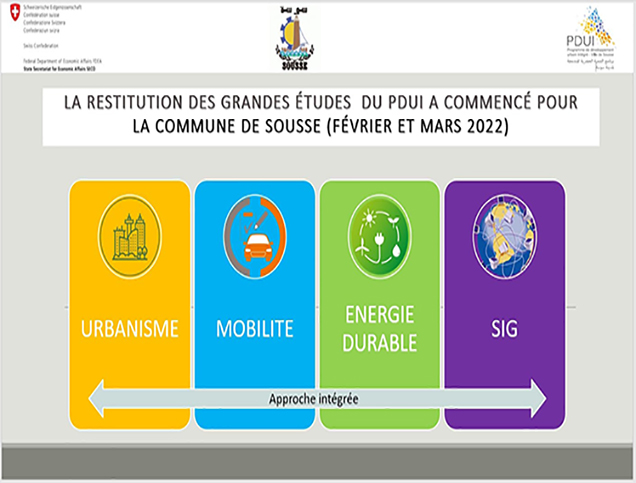
Close

Approach Words: Comprehensive Planning, Decentralised Cooperation, Participatory Approach
Public Policy Instruments: Communicative, Organization, Physical Intervention, Planning
The Integrated Urban Development Programme (IUDP) of the City of Sousse in Tunisia is a project within the framework of the decentralized cooperation between Swiss Confederation and the municipality of Sousse1 in the fields of Urban planning, Urban Management, and Geographic Information Systems (GIS)2.
The project seeks to enhance the quality of life in the city by improving the economic, environmental, and social conditions for the population3. It also aims to enhance the municipal institutional development by improving and maintaining the technical and organizational capacities of the municipality of Sousse4.

Title: Diagram showing the four main components of the Integrated Urban Development Programme.
Source: Click Here

Title: Focus Group Discussion during the formulation of strategic directions and choices for the revision of its Urban Development Plan (PAU).
Source: Click Here

Title: Revitalization of Boujaafar garden as one of the action plans.
Source: Click Here

Title: Testing the pedestrianization of the Boujaafar Corniche on 20 March 2022.
Source: Click Here
To meet these objectives, various comprehensive studies have been carried out in the four distinct fields of this integrated development program and include the following:
These various studies including master plans have enabled the formulation of strategies within the respective fields6. At the same time, the program has also introduced action plans and pilot projects that are highly visible and deliver quick, impactful results (referred to as “quick wins”), including the revitalization of the historic Boujaafar garden, Securing Pedestrian Crossings in the City Center and the initial testing of the pedestrianization of the Corniche that included an awareness campaign on soft mobility7 8. These pilot projects aimed to implement some of the strategies in these studies and deliver some of the above-mentioned objectives.

Owner/Developer (Public)

Consultant/Designer

Contractor/Implementer
The planning process adopts a participatory approach that engages both civil society and public actors in the formulation of strategic directions and choices for the integrated urban development plan. The participation is in the form of a series of listening and reflection workshops organized by the municipality9 10.
The project is initiated by the Municipality of Sousse, in collaboration with the Ministry of Local Affairs and Environment and with the support of the State Secretariat for Economic Affairs of the Swiss Confederation (SECO)11. The estimated budget of the project is CHF 2,800,000 funded by the Swiss Confederation12. A consortium led by Urbaplan, along with Transitec, Planair, and Inser, has been assigned the responsibility of providing project management assistance13. The project has been under implementation over two key phases:
Project Link
Endnotes
N.A.
References